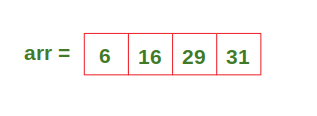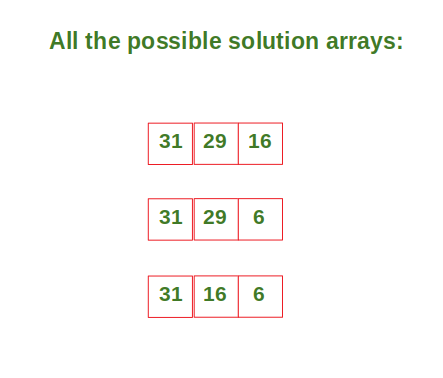给定n个公司和m个油矿具有价值,任务是以公平的方式在n个公司之间分配这些矿山。那就是获得最高矿产价值的公司与获得最低矿产价值的公司之间的差异应该是最小的。计算最小差异。请注意,分配给每个公司的油矿应彼此相邻。还, ![]()
例子:
Input: n = 2, m = 4
values of mines = [6, 10, 13, 2]
Output: 1 –> mines distributed as {(6, 10), (13, 2)}, hence output is (6+10) – (13+2) = 1
Input: n = 3, m = 4
values of mines = [6, 10, 13, 2]
Output: 9 –> mines distributed as {(6), (10), (13, 2)}, hence output is (13+2) – (6) = 9
资料来源:三星RnD 3小时编码回合问题
方法:
- 构造一个数组,使每个索引处的值包含当前值与该数组中所有先前值的和。
- 在我们的解决方案数组中包括数组中的最后一个值。
- 通过从倒数第二个索引开始的给定m-1个值中选择n-1个值,来递归构造所有可能的解决方案数组(因为数组的最后一个值已包含在我们的解决方案数组中)。
- 从解决方案数组中当前索引处的值中减去下一个索引处的值,以获取除最后一个值以外的每个索引处的值。计算所有解决方案数组的最大值和最小值之间的差,并返回最小值。
让我们以示例的方式逐步了解上述方法:
最初,提供的输入如下:

在步骤1之后,我们的数组看起来像下面给出的数组:

在步骤2之后,解决方案数组看起来像下面给出的数组:

在步骤3之后,我们得到以下可能的解决方案数组:

在第4步之后,我们的解决方案数组看起来像下面给出的数组。然后,我们为所有数组计算数组中最大值和最小值之间的差,并返回最小值(在本例中为9)。

下面是上述方法的实现:
# Python3 code to minimize the difference
# between the highest and lowest value containing company
# This function constructs the solution array
# recursively and returns the difference
# between the highest and lowest value.
def func(solArr, arr, index, n):
# If the values have been distributed,
# compute the difference
if n == 0:
for i in range(len(solArr)-1):
solArr[i] = solArr[i] - solArr[i + 1]
return max(solArr) - min(solArr)
else:
# solArr can be constructed even if we
# don't include the current value
if index >= n:
return min(func(solArr[:] + [arr[index]], arr, index-1, n-1),
func(solArr[:], arr, index-1, n))
# solArr can't be constructed hence
# we have to include the current value
else:
return func(solArr[:] + [arr[index]], arr, index-1, n-1)
n = 3
arr = [6, 10, 13, 2]
# Construct array such that value at each index
# contains the sum of current and all previous
# values in the array.
for i in range(1, len(arr)):
arr[i] += arr[i-1]
# Include the last value of
# the array in our solution array.
solArr = [arr[-1]]
print(func(solArr[:], arr, len(arr)-2, n-1))
输出:
9
时间复杂度: ![]()
空间复杂度: ![]()